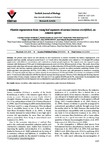Por favor, use este identificador para citar o enlazar este ítem:
http://www.alice.cnptia.embrapa.br/alice/handle/doc/1059742Registro completo de metadatos
| Campo DC | Valor | Lengua/Idioma |
|---|---|---|
| dc.contributor.author | MOREIRA, C. M. | pt_BR |
| dc.contributor.author | ANDRADE, H. B. de | pt_BR |
| dc.contributor.author | BERTOLUCCI, S. K. V. | pt_BR |
| dc.contributor.author | LAMEIRA, O. A. | pt_BR |
| dc.contributor.author | MOHAMMED, A. | pt_BR |
| dc.contributor.author | PINTO, J. E. B. P. | pt_BR |
| dc.date.accessioned | 2017-01-02T11:11:11Z | pt_BR |
| dc.date.available | 2017-01-02T11:11:11Z | pt_BR |
| dc.date.created | 2017-01-02 | pt_BR |
| dc.date.issued | 2016 | pt_BR |
| dc.identifier.citation | Turkish Journal of Biology, v. 40, n. 6, p. 1227-1234, 2016. | pt_BR |
| dc.identifier.uri | http://www.alice.cnptia.embrapa.br/alice/handle/doc/1059742 | pt_BR |
| dc.description | The present study reports the first efficient in vitro regeneration of Ananas erectifolius via indirect organogenesis. Leaf segments (leaf base, middle, and apex) excised from 3- or 5-week-old in vitro plantlets were cultured on 1/4 strength MS medium supplemented with different concentrations and combinations of plant growth regulators. The explants were also exposed to pulse treatment with thidiazuron (TDZ) and 2,4-dichlorophenoxyacetic acid (2,4-D) for different periods of time. The results showed that using juvenile rather than old explants enhanced the frequency of callus induction (35.0% and 16.0%, respectively). Among the explant types tested, only leaf base segments induced calli; the highest frequency occurred via culture treatment containing 4-amino-3,5,6- trichloropicolinic acid (picloram; 48.57%), 2,4-D (40%), or TDZ (35.71%). However, only calli generated in treatments containing TDZ or N6-isopentenyladenine (2ip) were able to develop shoots (maximum 35.71% and 14.28%, respectively). A combination of TDZ and 2,4-D improved callus induction (60.0%) but did not increase shooting response. However, both callusing and shooting response increased when 10 days of pulse treatment with TDZ and 2,4-D was applied (66.83% and 48.7%, respectively). Rooted plantlets that exhibited normal growth and development were acclimatized in a greenhouse and had a survival rate of 95%. | pt_BR |
| dc.language.iso | eng | eng |
| dc.rights | openAccess | eng |
| dc.subject | Regeneração in vitro | pt_BR |
| dc.title | Plantlet regeneration from young leaf segments of curaua (Ananas erectifolius), an Amazon species. | pt_BR |
| dc.type | Artigo de periódico | pt_BR |
| dc.date.updated | 2017-09-06T11:11:11Z | pt_BR |
| dc.subject.thesagro | Curaua | pt_BR |
| dc.subject.thesagro | Regeneração | pt_BR |
| dc.subject.nalthesaurus | thidiazuron | pt_BR |
| riaa.ainfo.id | 1059742 | pt_BR |
| riaa.ainfo.lastupdate | 2017-09-06 -03:00:00 | pt_BR |
| dc.identifier.doi | 10.3906/biy-1601-56 | pt_BR |
| dc.contributor.institution | Carolina Mariane MOREIRA, UFLA; Helena Botelho de ANDRADE, UFLA; Suzan Kelly Vilela BERTOLUCCI, UFLA; OSMAR ALVES LAMEIRA, CPATU; Aliyu MOHAMMED, Abant ?zzet Baysal University; José Eduardo Brasil Pereira PINTO, UFLA. | pt_BR |
| Aparece en las colecciones: | Artigo em periódico indexado (CPATU)  | |
Ficheros en este ítem:
| Fichero | Descripción | Tamaño | Formato | |
|---|---|---|---|---|
| CarolinaMoreiraPlantletregenerationcuraua2016.pdf | 1.06 MB | Adobe PDF |  Visualizar/Abrir |









